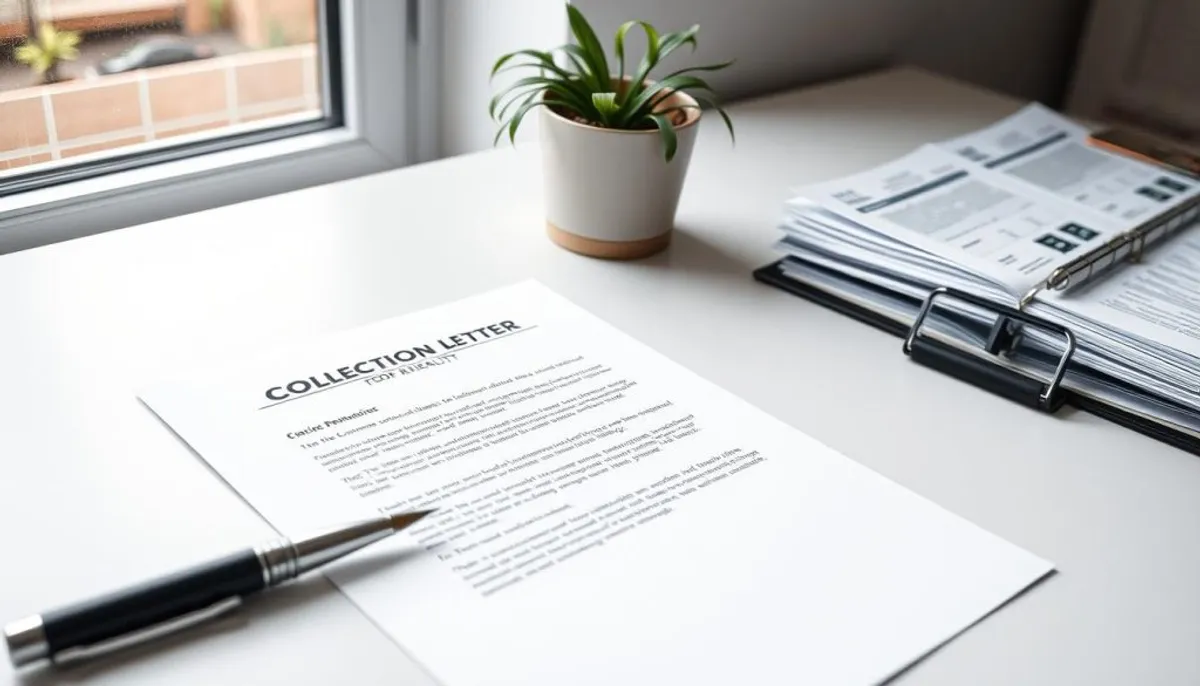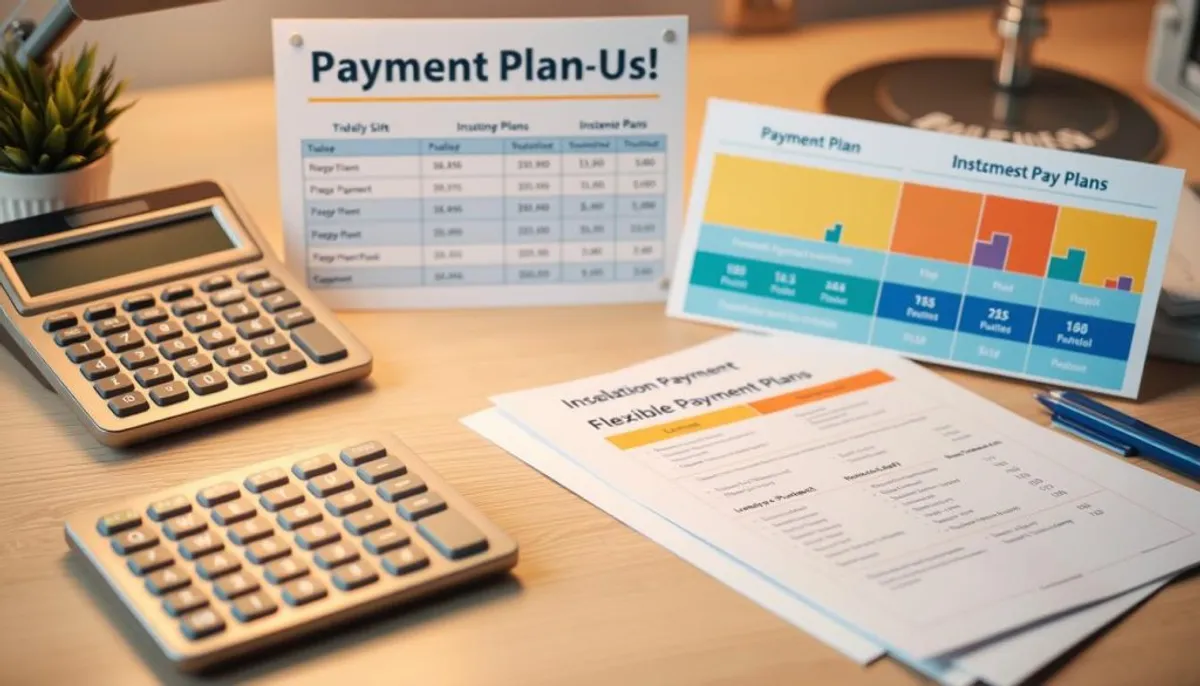Issuing a collection letter to clients with overdue invoices is a pivotal step in managing accounts receivable. These formal notifications are instrumental in reminding clients of unpaid bills, thus ensuring a steady cash flow. Crafting a collection letter that is both assertive and respectful of customer relationships is essential.
Businesses encounter substantial hurdles due to late payments. Typically, companies offering 28-day credit terms see payments delayed to 67 days. This delay can severely impact cash flow, posing a significant threat to smaller enterprises. In fact, 68% of businesses that receive over half their payments late face financial struggles.

When drafting collection letters, adherence to legal frameworks such as the Fair Debt Collection Practices Act is paramount. These regulations safeguard debtors from unfair practices while enabling businesses to pursue owed funds. An effective collection letter begins with a courteous tone, expressing gratitude for past business. It then clearly outlines the amount due, invoice details, and available payment options.
Effective collection letters are a component of a comprehensive strategy. They often follow email reminders and phone calls. The approach begins with gentle reminders, gradually escalating to more urgent messages. Offering various contact methods and payment plans can enhance response rates and aid in resolving overdue accounts.
Key Takeaways
- Collection letters are critical for managing accounts receivable and overdue invoices
- Late payments significantly impact business cash flow
- Legal compliance is essential when crafting collection letters
- A friendly yet firm tone helps maintain customer relationships
- Clear payment details and options can speed up the collection process
- Collection letters are part of a broader, escalating communication strategy
Understanding Collection Letters and Their Purpose
Collection letters are pivotal in debt recovery efforts. They are formal requests for payment aimed at recovering outstanding balances from customers. These letters serve as a formal record of debt collection attempts, potentially motivating debtors to settle their accounts.
Definition and Types of Collection Letters
Collection letters are formal notifications sent to customers with unpaid bills. They vary from gentle reminders to stern payment demands. The specific type of letter depends on the debt’s duration.
- Reminder letters: Sent 14 days after the due date
- Firm demand letters: Escalate the urgency for payment
- Final warning letters: Last step before legal action
Legal Requirements and Compliance
The Fair Debt Collection Practices Act (FDCPA) outlines the rules for collection letters. Adherence to these guidelines is essential to avoid legal repercussions. For instance, debtors have 30 days to dispute a debt after receiving a collection letter. Creditors must also provide evidence of the debt upon written request.
Impact on Business Relationships
Collection letters can influence customer relationships. While essential for debt recovery, they must be professional. Employing color and design to emphasize key information can enhance readability. Utilizing trackable letters ensures delivery to the intended recipient.
It’s worth noting that approximately 82% of businesses fail within five years due to financial mismanagement. Effective collection letters are crucial for maintaining cash flow and averting financial difficulties.
Essential Components of a Collection Letter to Customer
Creating an effective collection letter is vital for managing overdue invoices and delinquent accounts. A well-crafted letter boosts the likelihood of timely payment while fostering positive customer relations.
Required Information and Documentation
Every collection letter must include essential details for clarity and compliance. Begin with the customer’s personal information and your contact details. Include copies of overdue invoices, detailing the amounts owed and original due dates. If necessary, provide updated invoices with late fees.
Payment Details and Instructions
Offer various payment options to facilitate debt settlement. Clearly state accepted payment methods, such as credit cards, bank transfers, or checks. If payment plans are available, mention this to encourage communication from financially strained customers.
Timeline and Deadline Specifications
Establish clear payment expectations by setting a specific due date. Studies indicate that customers are more likely to act on a precise date rather than a general timeframe. Outline potential consequences of non-payment, like additional fees or account suspension, but ensure these are realistic and not threats.
It’s crucial to maintain a professional yet empathetic tone in your dunning notices. This approach helps maintain customer relationships while effectively addressing outstanding balances.
Best Practices for Professional Tone and Language

In crafting a collection letter, a professional tone is paramount. Your language must be clear, concise, and courteous, yet convey the urgency of overdue payments. It’s crucial to avoid aggressive or threatening words, as they can harm customer relationships and potentially breach legal boundaries.
Effective payment reminders should gradually increase in firmness. Begin with a friendly reminder, then move to more assertive language in subsequent letters. This method helps maintain positive rapport while achieving debt recovery goals.
Consider these statistics when writing collection letters:
- Lawyers collect payment for only 91% of invoiced hours
- Sending dunning emails before due dates improves communication
- Offering various payment options helps resolve issues
Utilizing templates for collection letters can save time and ensure consistency. Customize these templates to align with your brand voice and specific scenarios. Include all necessary information, such as invoice details, payment instructions, and deadlines.
| Letter Stage | Tone | Key Elements |
|---|---|---|
| First Reminder | Friendly | Payment request, due date, invoice details |
| Second Notice | Firm | Reminder of overdue payment, payment options |
| Final Notice | Urgent | Consequences of non-payment, immediate action required |
By adhering to these best practices, you can effectively communicate with customers about overdue payments. This approach maintains professionalism and preserves business relationships.
Structuring Your Collection Letter Effectively
A well-structured collection letter is crucial for successful debt recovery. Organizing your message effectively increases the likelihood of resolving outstanding balances promptly. Let’s examine the key components of an effective collection letter.
Opening Statement and Introduction
Begin your letter with a professional greeting. Clearly state your identity and company, followed by the purpose of your communication. For instance, “We’re reaching out regarding an unpaid invoice for services rendered on [date].” This establishes the tone for the rest of the letter.
Body Content Organization
In the letter’s body, present the facts about the outstanding balance. Include details such as invoice numbers, dates, and amounts due. Utilize bullet points to simplify this information. Clearly outline payment demands and offer various payment options to expedite resolution.
Closing Remarks and Call to Action
Conclude your letter with a compelling call to action. Specify the payment deadline and the consequences of non-payment. Include your contact information for any inquiries or concerns. A suitable closing might be, “Please remit payment by [date] to avoid further collection actions.”
The objective of your collection letter is to recover funds while preserving professional relationships. Adhering to this structure ensures a clear, actionable message. This encourages prompt payment of outstanding balances.
Using ti3 Platform for Automated Collection Management
The ti3 platform transforms accounts receivable management by streamlining overdue payments and automating payment reminders. It addresses the common challenges businesses encounter with unpaid invoices.
Features and Benefits Overview
Ti3 presents a suite of features aimed at enhancing collection efficiency:
- Automated SMS and email reminders
- Customizable payment plans for debtors
- Weekly follow-ups with settlement links
- Shareable payment links for partial payments
- Audit trails and compliance monitoring
These functionalities enable businesses to manage up to 1,000 overdue accounts concurrently. This significantly reduces the 14 hours weekly typically spent on collection tasks.
Integration with Existing Systems
Ti3 integrates seamlessly with current accounting systems. It reduces payment times from over 30 days to just 14 days. This integration addresses the 49% of invoices that become overdue in US businesses.
Customization Options
Businesses can tailor ti3 to their specific needs with flexible pricing options:
| Plan Type | Cost | Benefits |
|---|---|---|
| Per Invoice | 99 cents | Pay-as-you-go flexibility |
| Monthly Subscription | $49 | Reduced per-invoice cost to 49 cents |
With ti3, businesses can effectively manage overdue payments, enhance cash flow, and maintain positive customer relationships throughout the collection process.
Escalation Strategies for Unpaid Accounts
Debt recovery is essential for businesses with unpaid invoices. With SMBs facing $825 billion in delinquent accounts by 2023, effective escalation strategies are crucial. A structured approach aids in recovering payments and preserving customer relationships.
Begin with friendly reminders before and on the due date. If payment is still outstanding, send more assertive dunning notices. These should clearly outline the amount owed, payment instructions, and the consequences of non-payment.
After unsuccessful email attempts, consider direct phone calls for personal interaction. This can often resolve issues swiftly. If these efforts fail, send formal collection letters, emphasizing urgency and potential consequences.
- Use clear, direct language to avoid ambiguity
- Demonstrate empathy while emphasizing the importance of payment
- Offer assistance or alternative payment arrangements
- Maintain a polite-professional tone throughout
As a final measure, issue a legal notice indicating the intent to pursue legal action. Each step should be carefully timed and documented to maintain a clear record of collection efforts. Remember, automating collection emails can reduce past due accounts by 20% and enhance overall efficiency in managing delinquent accounts.
Maintaining Customer Relationships During Collections
Managing overdue invoices presents a significant challenge. It is crucial to maintain customer relationships while pursuing payment. Exploring effective strategies for this delicate balance is essential.
Communication Best Practices
When crafting a collection letter, prioritize clarity and politeness. Initiate with a gentle reminder 7-14 days post-due date. This approach conveys your commitment to timely payments without being confrontational. As the situation evolves, your communication can become more assertive, yet maintain respect.
Negotiation Techniques
Presenting flexible payment options demonstrates your willingness to collaborate with customers. This flexibility can expedite the settlement of outstanding accounts. For instance, proposing a payment plan for substantial overdue invoices can be beneficial. Engaging in dialogue to understand the customer’s perspective is also crucial. Such empathy can facilitate a mutually agreeable solution.
Resolution Strategies
When an invoice remains unpaid beyond 60 days, more robust measures may be necessary. Before resorting to legal actions, consider mediation or debt collection services. These avenues offer a constructive path towards resolution. It’s important to note that you generally have up to six years to pursue debt recovery. Always strive for amicable resolutions to safeguard customer relationships.
Legal Considerations and Compliance Requirements
Understanding the legal framework of debt recovery is paramount for businesses. The Fair Debt Collection Practices Act (FDCPA) establishes the foundational rules for debt collectors in the United States. It delineates the permissible times and methods for creditors to contact debtors, prohibits abusive practices, and safeguards debtors’ rights.
Issuing payment demands necessitates strict adherence to established guidelines. Dunning notices must present precise debt details and straightforward payment directives. The law also caps contact frequencies and bans deceptive tactics in debt collection endeavors.
State-specific regulations further complicate the debt recovery process. Each jurisdiction may impose its own statutes of limitations and collection methodologies. It is imperative for businesses to remain abreast of these local laws to circumvent legal entanglements.
Keeping meticulous records of all interactions and transactions is crucial. This approach not only facilitates debt recovery but also serves as a safeguard against potential disputes. Increasingly, businesses are leveraging specialized software to manage these records and uphold compliance standards.
For entities grappling with debt collection, seeking legal counsel is highly beneficial. Legal experts can guide through the intricate network of federal and state regulations. They ensure that all debt recovery activities are compliant and productive.
Payment Plan Options and Flexibility
Managing outstanding balances poses significant challenges for businesses. Implementing flexible payment plans can enhance the likelihood of recovering overdue payments while fostering positive customer relationships. This section delves into strategies for structuring and efficiently managing payment arrangements.
Structuring Payment Arrangements
When devising payment plans, it’s essential to consider both the customer’s financial standing and your business objectives. Propose realistic payment options that enable gradual debt repayment. For example, monthly installments or a single payment with a discount for early settlement are viable alternatives. Tailoring plans to individual circumstances can significantly boost debt recovery success.

Documentation Requirements
Accurate documentation is paramount in establishing payment plans. Ensure all terms, including payment amounts, due dates, and penalties for late payments, are clearly outlined. This clarity prevents miscommunication and serves as a reference for both parties. It’s imperative to have the customer sign and date the agreement, affirming their commitment to the plan.
Monitoring and Follow-up Procedures
Establish a comprehensive system for monitoring payment plan adherence. Utilize automated payment reminders to notify customers of upcoming payments. In the event of a missed payment, address the issue promptly. Demonstrating flexibility while pursuing debt resolution is crucial.
- Send payment reminders 3-5 days before each due date
- Follow up within 24 hours of a missed payment
- Review payment plans quarterly to assess effectiveness
By offering adaptable payment options and maintaining open communication, businesses can adeptly manage overdue payments. This approach not only aids in debt recovery but also preserves valuable customer relationships.
Conclusion
In today’s financial environment, the ability to write an effective collection letter is paramount. With 77% of American households burdened by debt, the necessity for transparent communication in accounts receivable is heightened. A well-crafted collection letter can substantially enhance debt recovery efforts, ensuring businesses sustain a healthy cash flow.
The debt recovery process is intricate, with one-quarter of Americans facing difficulties in timely bill payments. Employing tools like ti3 for automated collection management can streamline accounts receivable processes. This method not only enhances efficiency but also fosters positive customer relations during financially challenging times.
It is essential to remember that the primary objective of a collection letter extends beyond mere debt recovery. Given that 72% of Americans endure monthly financial stress, it is critical to approach collections with empathy and professionalism. By adhering to the best practices discussed in this guide, you can create collection letters that are both effective and respectful. This approach will contribute significantly to your business’s long-term success in the complex realm of debt recovery.
RelatedRelated articles



